Search the Special Collections and Archives Portal
Search Results

Film transparency of the mountains near Virginia City, Nevada, circa 1940s
Date
1940 to 1949
Archival Collection
Description
The mountains near Virginia City, Nevada. Virga can be seen falling from the clouds. Like many cities and towns in Nevada, Virginia City was a mining boomtown; it developed virtually overnight as a result of miners rushing to the Comstock Lode silver strike of 1859 on the eastern slopes of Mount Davidson. But, Virginia City far surpassed all others for its peak of population, technological advancements developed there, and for providing the population base upon which Nevada qualified for statehood. The riches of the Comstock Lode inspired men to hunt for silver mines throughout Nevada and other parts of the American West. At its peak, Virginia City had a population of over 25,000 residents and was called the richest city in America. Dominated by San Francisco moneyed interests, Virginia City was heralded as the sophisticated interior partner of San Francisco. “San Francisco on the coast and Virginia City inland” became the mantra of west coast Victorian entrepreneurs. Early Virginia City settlers were in large part the backwash from San Francisco and the California Gold Rush, ten years before. Mine owners who made a killing in the Comstock mines spent most of their wealth in San Francisco.
Image
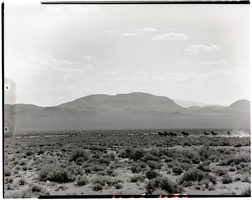
Film transparency of a herd of wild horses, Goldfield, Nevada, circa 1940s
Date
1940 to 1948
Archival Collection
Description
A herd of wild horses race across the desert, just south of Goldfield, Nevada.
Image
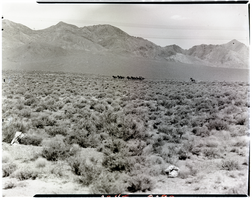
Film transparency of a herd of wild horses, Goldfield, Nevada, July 16, 1949
Date
1949-07-16
Archival Collection
Description
A herd of wild horses race across the desert, just south of Goldfield, Nevada.
Image
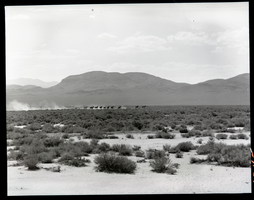
Film transparency of a herd of wild horses, Goldfield, Nevada, July 16, 1949
Date
1949-07-16
Archival Collection
Description
A herd of wild horses race across the desert, just south of Goldfield, Nevada.
Image
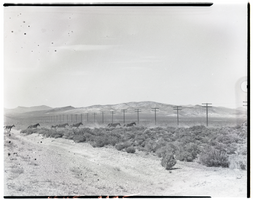
Film transparency of a herd of wild horses, Goldfield, Nevada, July 16, 1949
Date
1949-07-16
Archival Collection
Description
A herd of wild horses near power lines in the desert, just south of Goldfield, Nevada.
Image
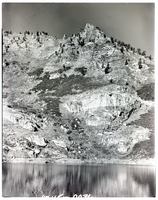
Film transparency of Angel Lake, Nevada, November 10, 1976
Date
1976-11-10
Archival Collection
Description
Angel Lake, Nevada. Angel Lake is a glacial tarn in the northern part of the East Humboldt Range, in central Elko County in the northeastern part of the state of Nevada. It is located at approximately 41°01.6?N 115°05.1?W, and at an elevation of 8378 feet (2553 m). It has an area of approximately 13 acres (5.2 hectares), and a depth of up to 29 feet (9 m). A 12-mile (19 km) scenic highway, State Route 231, climbs from Interstate 80's exit 351 in Wells to the eastern shore of the lake. Located at the base of a steep cirque, the lake is surrounded by high cliffs. Greys Peak (10,674 ft, 3253 m) rises high to the west, and to the south is a group of pinnacles known as Chimney Rock. Far below and to the east lies Clover Valley and the community of Wells.
Image
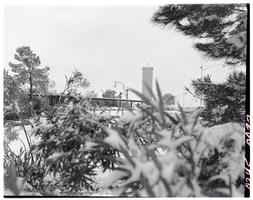
Film transparency of the Flamingo Hotel and Casino, Las Vegas, Nevada, January 7, 1955
Date
1955-01-07
Archival Collection
Description
The Flamingo Hotel and Casino in Las Vegas, Nevada, as seen through a snow-laden bush. The Marquee is visible in the background, advertising Tony Martin, The Goofers, The interludes, Ron Fletcher, Salmas Brothers, Bobby Page, and others. Benjamin "Busgsy" Siegel, opened The Flamingo Hotel & Casino at a total cost of $6 million on December 26, 1946 to poor reception and soon closed. It reopened in March 1947 with a finished hotel. Three months later, on June 20, 1947, Siegel was shot dead at the Beverly Hills home of his girlfriend, Virginia Hill. Billed as "The West's Greatest Resort Hotel," the 105-room property and first luxury hotel on the Strip, was built 4 miles (6.4 km) from Downtown Las Vegas, with a large sign built in front of the construction site announcing it was a William R. Wilkerson project, with Del Webb Construction as the prime contractor and Richard R. Stadelman (who later made renovations to the El Rancho Vegas) the architect. Lore has it that Siegel named the resort after his girlfriend Virginia Hill, who loved to gamble and whose nickname was "Flamingo," a nickname Siegel gave her due to her long, skinny legs. Organized crime king Lucky Luciano wrote in his memoir that Siegel once owned an interest in the Hialeah Park Race Track and viewed the flamingos who populated nearby as a good omen. In fact, the "Flamingo" name was given to the project at its inception by Wilkerson.
Image
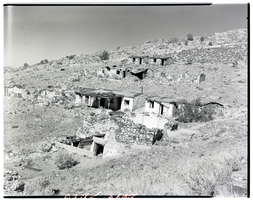
Film transparency of a ghost town, Delamar, Nevada, 1956
Date
1956
Archival Collection
Description
A view of some of the abandonded buildings on a hillside in Delamar, Nevada. One of the structures has a covered porch Delamar, Nevada, nicknamed The Widowmaker, is a ghost town in central eastern Nevada, USA along the east side of the Delamar Valley. During its heyday, primarily between 1895 and 1900, it produced $13.5 million in gold. In 1889, prospectors John Ferguson and Joseph Sharp discovered gold around Monkeywrench Wash. A mining camp was then born west of the Monkeywrench Mine. It was called Ferguson. In April 1894, Captain Joseph Raphael De Lamar bought most of the important mines in the area and renamed the Ferguson camp as Delamar. In the same year, a newspaper called the Delamar Lode began publication and a post office was opened. Soon, the new settlement boasted more than 1,500 residents, a hospital, an opera house, churches, a school, several businesses and saloons. Most buildings were made of native rock. By 1896, the Delamar mill was handling up to 260 tons of ore daily. Water for the camp was pumped from a well in Meadow Valley Wash, some twelve miles away. Supplies and materials traveled even further, by mule team over mountainous terrain from the railroad head at Milford, Utah, which was 150 miles from Delamar. Silicosis The gold in the Delamar mines was embedded in quartzite which when crushed created a fine dust. Miners breathing the dust often developed silicosis and the town became known as a "widow-maker." Many ruins now stand semi-intact in the Delamar ghost town region. Foundations can easily be seen from adjacent hills. There are two graveyards, which have been vandalized. The area is honeycombed with mines and mineshafts, but in recent years the main shaft has been blasted closed. Wild horses roam the area. The nearby dry lake is known to pilots as Texas Lake because its outline resembles the state of Texas.
Image
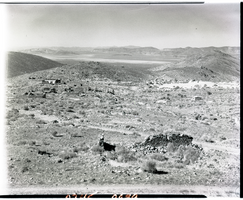
Film transparency of a ghost town, Delamar, Nevada, 1956
Date
1956
Archival Collection
Description
A view of some of the abandonded buildings in Delamar, Nevada, taken from a nearby hill. Delamar, Nevada, nicknamed The Widowmaker, is a ghost town in central eastern Nevada, USA along the east side of the Delamar Valley. During its heyday, primarily between 1895 and 1900, it produced $13.5 million in gold. In 1889, prospectors John Ferguson and Joseph Sharp discovered gold around Monkeywrench Wash. A mining camp was then born west of the Monkeywrench Mine. It was called Ferguson. In April 1894, Captain Joseph Raphael De Lamar bought most of the important mines in the area and renamed the Ferguson camp as Delamar. In the same year, a newspaper called the Delamar Lode began publication and a post office was opened. Soon, the new settlement boasted more than 1,500 residents, a hospital, an opera house, churches, a school, several businesses and saloons. Most buildings were made of native rock. By 1896, the Delamar mill was handling up to 260 tons of ore daily. Water for the camp was pumped from a well in Meadow Valley Wash, some twelve miles away. Supplies and materials traveled even further, by mule team over mountainous terrain from the railroad head at Milford, Utah, which was 150 miles from Delamar. Silicosis The gold in the Delamar mines was embedded in quartzite which when crushed created a fine dust. Miners breathing the dust often developed silicosis and the town became known as a "widow-maker." Many ruins now stand semi-intact in the Delamar ghost town region. Foundations can easily be seen from adjacent hills. There are two graveyards, which have been vandalized. The area is honeycombed with mines and mineshafts, but in recent years the main shaft has been blasted closed. Wild horses roam the area. The nearby dry lake is known to pilots as Texas Lake because its outline resembles the state of Texas.
Image

Film transparency of a ghost town, Delamar, Nevada, 1956
Date
1956
Archival Collection
Description
Some of the abandonded buildings in Delamar, Nevada. A tailing pile from one of the mines is visible in the center of the photograph. A stone structure is visible on the right side of the photograph. Delamar, Nevada, nicknamed The Widowmaker, is a ghost town in central eastern Nevada, USA along the east side of the Delamar Valley. During its heyday, primarily between 1895 and 1900, it produced $13.5 million in gold. In 1889, prospectors John Ferguson and Joseph Sharp discovered gold around Monkeywrench Wash. A mining camp was then born west of the Monkeywrench Mine. It was called Ferguson. In April 1894, Captain Joseph Raphael De Lamar bought most of the important mines in the area and renamed the Ferguson camp as Delamar. In the same year, a newspaper called the Delamar Lode began publication and a post office was opened. Soon, the new settlement boasted more than 1,500 residents, a hospital, an opera house, churches, a school, several businesses and saloons. Most buildings were made of native rock. By 1896, the Delamar mill was handling up to 260 tons of ore daily. Water for the camp was pumped from a well in Meadow Valley Wash, some twelve miles away. Supplies and materials traveled even further, by mule team over mountainous terrain from the railroad head at Milford, Utah, which was 150 miles from Delamar. Silicosis The gold in the Delamar mines was embedded in quartzite which when crushed created a fine dust. Miners breathing the dust often developed silicosis and the town became known as a "widow-maker." Many ruins now stand semi-intact in the Delamar ghost town region. Foundations can easily be seen from adjacent hills. There are two graveyards, which have been vandalized. The area is honeycombed with mines and mineshafts, but in recent years the main shaft has been blasted closed. Wild horses roam the area. The nearby dry lake is known to pilots as Texas Lake because its outline resembles the state of Texas.
Image
Pagination
Refine my results
Content Type
Creator or Contributor
Subject
Archival Collection
Digital Project
Resource Type
Year
Material Type
Place
Language
Records Classification
